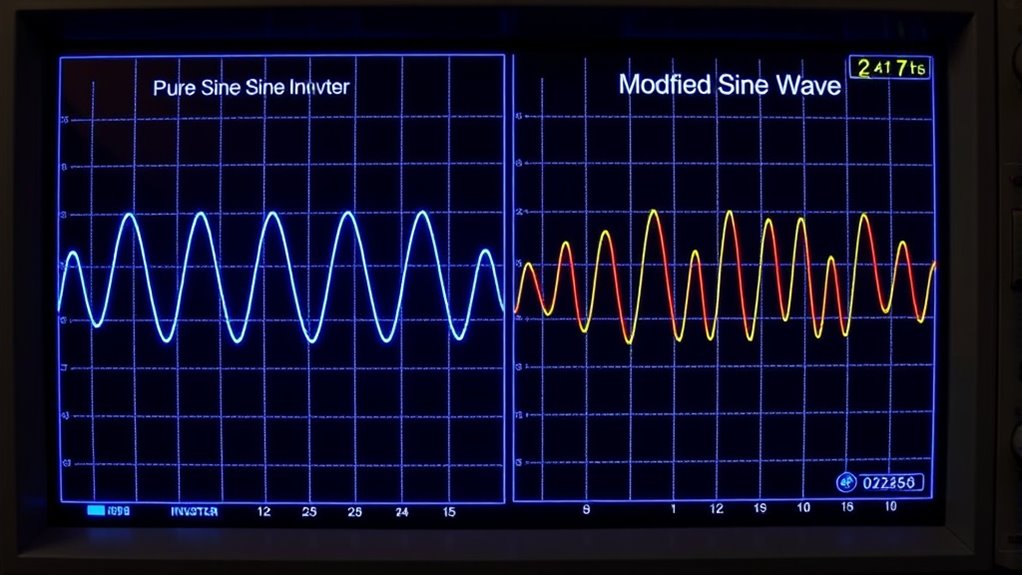Choosing between pure and modified sine wave inverters depends on your electronic needs. Pure sine inverters produce a smooth, utility-like waveform perfect for sensitive devices, while modified sine inverters offer a stepped, more basic wave that can cause noise or malfunctions in some electronics. Although pure sine models tend to be pricier, they guarantee better performance and longer device lifespan. To understand how each impacts your appliances and what fits your budget, explore the details further.
Key Takeaways
- Pure sine wave inverters produce smooth, clean power similar to utility grids, ideal for sensitive electronics.
- Modified sine wave inverters generate a stepped, less smooth waveform that may cause noise or malfunction in some devices.
- Pure sine inverters are generally more expensive but offer higher efficiency and device compatibility.
- Modified sine inverters are affordable and simpler but can lead to increased noise, reduced lifespan, and device issues.
- Choosing the correct waveform depends on application sensitivity, device requirements, and cost considerations.
Understanding Waveform Types and Their Characteristics

When exploring inverter waveforms, understanding the different types and their unique characteristics is vital. Waveform clarity varies markedly among inverter types, impacting how smoothly your devices operate. Pure sine wave inverters produce a clean, smooth waveform that closely mimics utility power, guaranteeing high waveform clarity and ideal power stability. Modified sine wave inverters, on the other hand, generate a stepped, less smooth waveform, which can cause minor disturbances in sensitive electronics. Knowing these differences helps you choose the right inverter for your needs. Waveform clarity directly affects device performance, while power stability ensures consistent operation. The technology used in inverter design, such as DLP vs. LCD technology, influences the quality of power output and overall waveform fidelity. Additionally, waveform complexity plays a significant role in determining how well an inverter can simulate a pure sine wave. For instance, the electronic components within an inverter determine its ability to produce a stable and accurate waveform. A deeper understanding of power modulation techniques can also aid in selecting an inverter with optimal performance. Moreover, advances in automation technology are paving the way for smarter, more adaptive inverters that can better handle varying load conditions. By understanding these core characteristics, you’ll be better equipped to select an inverter that provides reliable, stable power tailored to your specific requirements.
How Pure Sine Wave Inverters Work

Pure sine wave inverters generate an output waveform that closely resembles the smooth, continuous shape of utility power. They achieve this by rapidly switching the DC input into AC, creating a clean, stable sine wave. This process guarantees your sensitive electronics operate smoothly without noise or distortion. Selecting the right inverter sizing depends on your power needs, and understanding your battery chemistry helps optimize performance and longevity. The inverter adjusts its output based on load demands, producing a true sine wave that’s ideal for complex electronics. Additionally, knowing battery chemistry ensures you select an inverter that matches your system’s characteristics for optimal efficiency and durability. Properly matching inverter specifications with your system’s power requirements can prevent potential issues and extend the lifespan of your equipment. As technology advances, integrating AI-powered monitoring can further enhance inverter performance and system reliability. Implementing quality components in your inverter setup can also significantly improve overall system stability and efficiency.
The Mechanics of Modified Sine Wave Inverters

Modified sine wave inverters operate by producing a stepped approximation of a sine wave through a series of switchings between positive and negative voltage levels. This process creates a waveform that mimics a true sine wave but with abrupt transitions. Because of these switchings, your battery life can be affected; the inverter draws more current, potentially reducing overall battery capacity over time. Additionally, the sharp voltage changes generate higher noise levels compared to pure sine inverters. You might notice humming sounds or electrical interference, especially with sensitive devices. While modified sine inverters are more affordable and simpler to operate, understanding their mechanics helps you anticipate their impact on your system’s efficiency and noise. This knowledge guarantees better choices for your power needs and equipment longevity. For example, researching the impact of waveform types on specific electronic devices can help determine the most suitable inverter for your application. Furthermore, selecting the right inverter can help minimize undesirable effects like electrical noise and device malfunctions. Recognizing sound wave characteristics can provide further insight into how different inverters interact with various electrical loads, and understanding the core principles of waveform generation enhances your ability to evaluate inverter performance. Being aware of AI security vulnerabilities can also guide you in choosing inverters with built-in safety features to prevent potential risks.
Impact on Household and Sensitive Equipment

The waveform quality produced by modified sine wave inverters can considerably affect household and sensitive electronic devices. Medical devices, such as infusion pumps or monitors, often rely on clean power; a distorted waveform may cause malfunctions or inaccuracies. Audio equipment, including speakers and amplifiers, can experience increased noise, hum, or distortion with a modified sine wave, degrading sound quality. Sensitive electronics may also face stress or reduced lifespan due to inconsistent power delivery. You might notice your medical devices malfunctioning or your audio setup producing unwanted background noise. While these inverters are more affordable, their impact on critical and delicate equipment can be significant, leading to potential repair costs or compromised performance. Always consider waveform quality when powering sensitive household or medical devices. Additionally, the celebrity lifestyle insights discussed earlier highlight how even high-profile individuals pay attention to quality and reliability in their personal environments. In fact, understanding the waveform types can help consumers make informed decisions to protect their valuable electronics. Proper understanding of power quality is essential to avoiding damage and ensuring longevity of your devices. Being aware of electronic device sensitivity can further guide your choice of inverter waveform for optimal protection. Recognizing the importance of tuning and modifications in automotive contexts underscores the need for high-quality power supplies to maintain performance and reliability.
Cost, Efficiency, and Practical Considerations

While inverter waveforms vary in cost and efficiency, understanding these factors is essential for making an informed choice. Pure sine inverters tend to have a higher price comparison due to their complex circuitry and premium components, but they offer better efficiency and smoother power output. Modified sine inverters are more affordable and simpler to install, making them appealing for budget-conscious setups. However, their lower efficiency can lead to increased energy loss over time. When considering practical aspects, evaluate the installation complexity; pure sine inverters often require more careful setup, while modified sine models are generally straightforward. Additionally, power quality is a crucial factor that can influence the performance of sensitive electronic devices. Understanding inverter waveforms can help you select the most suitable option for your application, balancing upfront costs with long-term performance and ease of installation will help you select the best inverter waveform for your specific needs. For example, in Gold IRA investments, the choice of a reliable provider and understanding the associated costs and benefits is equally important to ensure a secure retirement strategy. Considering electrical safety standards is also vital when choosing and installing an inverter to prevent potential hazards. Furthermore, being aware of Glycolic Acid Benefits for Skin can assist in maintaining skin health during extended periods of device operation or exposure to environmental factors.
Frequently Asked Questions
How Do Inverter Waveforms Affect Audio and Video Device Performance?
You’ll notice that inverter waveforms impact your audio and video device performance by causing waveform distortion, which can lead to poor audio quality and video flickering. Pure sine wave inverters provide cleaner power, ensuring smooth operation and high-quality sound and visuals. In contrast, modified sine wave inverters may introduce electrical noise, resulting in reduced audio clarity and potential device malfunctions. Choose your inverter carefully for ideal device performance.
Can Modified Sine Wave Inverters Power All Types of Appliances Reliably?
Modified sine wave inverters can power many appliances reliably, but their appliance compatibility varies. They work well with simple devices like lights, chargers, and some power tools, thanks to their waveform efficiency. However, sensitive electronics like audio equipment, medical devices, and certain motor-driven appliances may not perform well or could be damaged. Always check your appliance’s specifications to guarantee compatibility with modified sine wave inverters for safe, reliable operation.
What Is the Lifespan Comparison Between Pure and Modified Sine Wave Inverters?
You might think pure sine wave inverters last longer, but surprisingly, their lifespan isn’t drastically different from modified sine inverters. Both can suffer from battery degradation and inverter durability issues over time. However, pure sine inverters often face fewer stress-related failures, thanks to smoother power delivery. Ironically, spending more on a pure sine inverter might just buy you a slightly longer lifespan, but don’t expect miracles.
Are There Safety Concerns With Using Modified Sine Wave Inverters?
Using a modified sine wave inverter can raise safety concerns, especially regarding electrical interference that might disrupt sensitive devices. You should check device compatibility, as some electronics may overheat or malfunction without the smooth power of a pure sine wave. While generally safe for many applications, you need to be cautious with medical equipment or audio systems to prevent damage or performance issues.
How Do Inverter Waveforms Influence Battery Life and Energy Consumption?
Think of inverter waveforms as the heartbeat of your power system. Modified sine wave inverters often cause your battery to work harder, reducing battery efficiency and potentially shortening battery life. This increased strain can also impact inverter durability over time. By choosing a pure sine wave, you guarantee smoother energy flow, conserving your battery’s energy and extending its lifespan, ultimately making your setup more reliable and cost-effective.
Conclusion
Ultimately, choosing between pure and modified sine wave inverters involves subtle nuances that can influence your equipment’s harmony and longevity. While pure sine inverters offer a more refined experience, their higher cost might suggest a gentle nudge toward practicality. Conversely, modified sine inverters present a balanced compromise, subtly catering to everyday needs without overwhelming your budget. By weighing these delicate distinctions, you can make an informed decision that gracefully aligns with your energy needs and lifestyle.









